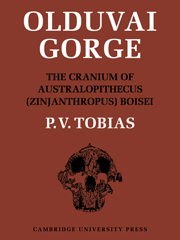Book contents
- Frontmatter
- Contents
- List of text-figures
- List of plates
- List of tables
- Introductory Note
- Foreword
- Editor's Note
- Acknowledgements
- I Introduction
- II Preservation and reconstruction of the cranium
- III The cranial vault
- IV The basis cranii externa
- V Certain critical angles and indices of the cranium
- VI The interior of the calvaria
- VII The thickness of the cranial bones
- VIII The endocranial cast of Zinjanthropus
- IX Metrical characters of the calvaria as a whole
- X The structure of the face
- XI The pneumatisation of the Zinjanthropus cranium
- XII The dental arcade and the palate
- XIII The pattern of dental attrition and occlusion, with comments on enamel hypoplasia
- XIV The size of individual teeth, absolute and relative
- XV The size of the dentition as a whole
- XVI The crown shape index of the teeth
- XVII The morphology of the teeth
- XVIII Summary of cranial and dental features of Zinjanthropus
- XIX The taxonomic status of Zinjanthropus and of the australopithecines in general
- XX The cultural and phylogenetic status of Australopithecus boisei and of the australopithecines in general
- References
- Index of persons
- Index of subjects
- Plate section
XX - The cultural and phylogenetic status of Australopithecus boisei and of the australopithecines in general
Published online by Cambridge University Press: 05 November 2011
- Frontmatter
- Contents
- List of text-figures
- List of plates
- List of tables
- Introductory Note
- Foreword
- Editor's Note
- Acknowledgements
- I Introduction
- II Preservation and reconstruction of the cranium
- III The cranial vault
- IV The basis cranii externa
- V Certain critical angles and indices of the cranium
- VI The interior of the calvaria
- VII The thickness of the cranial bones
- VIII The endocranial cast of Zinjanthropus
- IX Metrical characters of the calvaria as a whole
- X The structure of the face
- XI The pneumatisation of the Zinjanthropus cranium
- XII The dental arcade and the palate
- XIII The pattern of dental attrition and occlusion, with comments on enamel hypoplasia
- XIV The size of individual teeth, absolute and relative
- XV The size of the dentition as a whole
- XVI The crown shape index of the teeth
- XVII The morphology of the teeth
- XVIII Summary of cranial and dental features of Zinjanthropus
- XIX The taxonomic status of Zinjanthropus and of the australopithecines in general
- XX The cultural and phylogenetic status of Australopithecus boisei and of the australopithecines in general
- References
- Index of persons
- Index of subjects
- Plate section
Summary
Cultural status
It has long been known that pebble-tools were made in Africa during the period of the australopithecines. But there have been two schools of thought on the relationship between the fossils and the implements. According to one view, Australopithecus was the maker of these stone implements. The notion has been forthrightly expressed by J. D. Clark as recently as 1963: ‘To take the example of the australopithecines:–Few would now doubt that they were representative of a hominid form responsible for the Pre-Chelles-Acheul Culture’ (p. 356). This view has been espoused by Arambourg (1958), by Oakley (1961, 1964) although he earlier (1954, 1956) took the opposing view, by Washburn (1959), Washburn and Howell (1960), Washburn and De Vore (1961), and others.
Exponents of the second view have doubted whether the australopithecines were stone toolmakers (Robinson and Mason, 1957, 1962; Inskeep, 1959; Mason, 1961; von Koenigswald, 1961, etc.).
In favour of the first view are the contemporaneity of the australopithecines and the pebbletools, and the discovery of a fragmentary, apparently australopithecine maxilla and a few possible pebble-tools in the same layer near the top of the Makapansgat deposit (Brain, Van Riet Lowe and Dart, 1955; Dart, 1955b). This discovery Dart (1955b) described as ‘providing the first concrete evidence that an australopithecine type…was contemporaneous with, and may have been responsible for, the concomitant pebble culture found in this sealed Central Transvaal cavern deposit’.
Information
- Type
- Chapter
- Information
- Olduvai Gorge , pp. 236 - 244Publisher: Cambridge University PressPrint publication year: 1967
